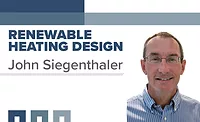John Siegenthaler: Btus in a box
There’s more to comfort than balanced energy flows.

Have you noticed the strong interest in cold-climate air-source heat pumps over the last couple of years?
This past January, I walked the AHR trade show in Atlanta. Dozens of booths prominently displayed ductless “mini-split” air-source heat pumps systems, or their commercial equivalent — variable refrigerant flow (VRF) systems. These products define two of the fastest growing segments of the North American HVAC market.
Ductless air-source heat pumps are easy to recognize: Most have one or more “high wall” air handlers coupled to an outdoor condenser unit using one or more refrigerant line sets. Most ductless heat pumps now have variable speed compressors, ECM blowers, self-diagnostics, and of course, an app allowing you to control the system from your smartphone. Some of the ductless air handlers have become very stylish, with sleek cabinets and fancy wireless remotes. Some of the air handlers are disguised as (rather thick) “picture frames” for displaying the occupants favorite artwork. I’m sure very few people would ever notice that the artwork frame is an air handler — at least when the picture frame’s blower is off!
Looking for a reprint of this article?
From high-res PDFs to custom plaques, order your copy today!









